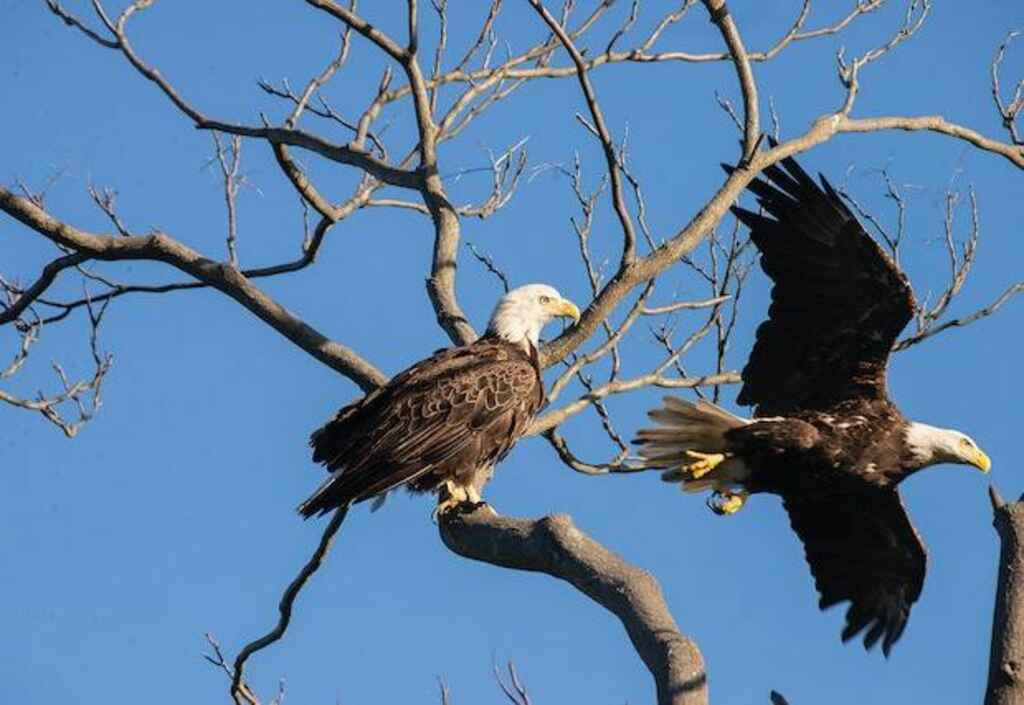What Do Eagles Look Like? Brace yourself for a breathtaking encounter with nature’s aerial marvels!
These majestic creatures are renowned for their powerful flight, spanning continents from North America to Africa and Eurasia.
With razor-sharp talons, hooked beaks, and eyesight that could spot a needle in a haystack, they’re the epitome of skilled hunters.
Join us on a journey through their awe-inspiring size, distinct features, and cultural significance.
Discover how these regal birds capture our hearts and face challenges in an ever-changing world. Prepare for an enchanting exploration like no other!
Table of Contents
- 1 Key Takeaways
- 2 Overview of Eagles and their Importance
- 3 What Do Eagles Look Like
- 4 Size and Physical Characteristics
- 5 Differences between Male and Female Eagles
- 6 The Importance of Eagles’ Eyesight
- 7 Flight Abilities of Eagles
- 8 Hunting Techniques of Eagles
- 9 Comparison of Eagles to Other Birds of Prey
- 10 Eagles in Mythology and Culture
- 11 Endangered Status of Eagles
- 12 Places to See Eagles in the Wild
- 13 Final Thoughts on Eagles and their Beauty
- 14 Frequently Asked Questions
- 15 Conclusion
- 16 Author
Key Takeaways
- Eagles are found in various parts of the world, with the bald eagle being a symbol of freedom in the US.
- Male and female eagles have noticeable physical differences, with females generally being larger and heavier.
- Eagles possess exceptional visual acuity due to adaptations, and a range of physical adaptations allow impressive aerial feats and hunting techniques.
- Eagles hold great symbolism in various cultures and have a significant place in mythology and art, often depicted as fierce and majestic creatures.
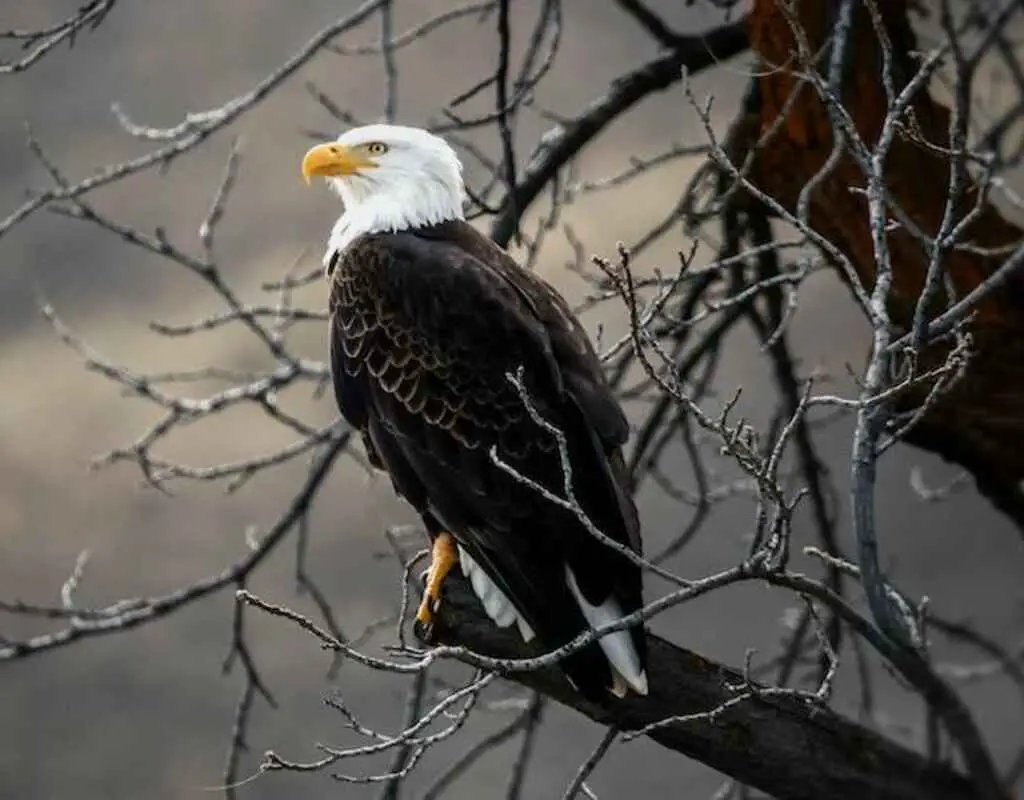
Overview of Eagles and their Importance
The significance of eagles as a keystone species in their respective ecosystems makes them a subject of interest for conservation efforts, which underscores their importance beyond their iconic appearance.
Conservation efforts have been implemented to protect eagles and their habitats, as they play a crucial role in maintaining a balanced ecosystem.
Eagles also hold great symbolism and meaning in various cultures, representing freedom, strength, and majesty.
However, their physical characteristics are equally fascinating. From their sharp talons and hooked beaks to their impressive wingspans and keen eyesight, eagles are truly remarkable creatures.
Their size and physical characteristics enable them to thrive in their natural habitats, making them a formidable predator.
What Do Eagles Look Like
Eagles are large birds of prey known for their impressive size and majestic appearance. They typically have a wingspan ranging from 6 to 8 feet.
Eagles have strong, hooked beaks, sharp talons, and keen eyesight. Their plumage varies, but they commonly exhibit dark brown feathers on their bodies, with lighter feathers on their heads and tails.
Some species, like the bald eagle, have distinctive white heads and tails, while others display various patterns and colors.
Overall, eagles are renowned for their regal stature and formidable hunting capabilities.
Size and Physical Characteristics
Significant variations in the size and physical characteristics of eagles exist, depending on their species and location.
Generally, eagles are large birds of prey with powerful talons and sharp beaks, designed for hunting and feeding on a variety of prey such as fish, small mammals, and birds.
Eagle habitats vary widely, from coastal regions to mountainous areas, and they have adapted to their environments accordingly.
For instance, eagles living near water sources have specialized feathers that repel water and enable them to dive into the water to catch fish.
Nesting behaviors also vary among eagle species, with some building nests on cliffs or in trees, while others construct more elaborate structures on the ground.
Understanding the physical characteristics and habits of eagles is crucial for their conservation and management. The next section will explore the differences between male and female eagles.
Differences between Male and Female Eagles
Notably, the physical differences between male and female eagles are often subtle, but can be crucial for identifying the gender of the bird.
Male eagles are generally smaller than females, with a wingspan that ranges from 6 to 7 feet, while females have a wingspan that ranges from 7 to 8 feet.
Female eagles are also heavier, with a weight that can reach up to 14 pounds, whereas males weigh around 8–10 pounds.
In terms of appearance, female eagles often have a larger beak and head, as well as a deeper and wider body. However, behavioral differences between the sexes are more pronounced.
Male eagles are usually more aggressive and territorial, whereas females tend to be more nurturing and protective of their offspring.
These differences in behavior and breeding habits can give important insights into the social dynamics of eagle populations.
Understanding these differences can be helpful in conservation efforts, as it helps to identify the needs of each gender and develop strategies to protect their habitats.
Moving forward, it is important to recognize the role of eagle’s eyesight in their survival and behavior.
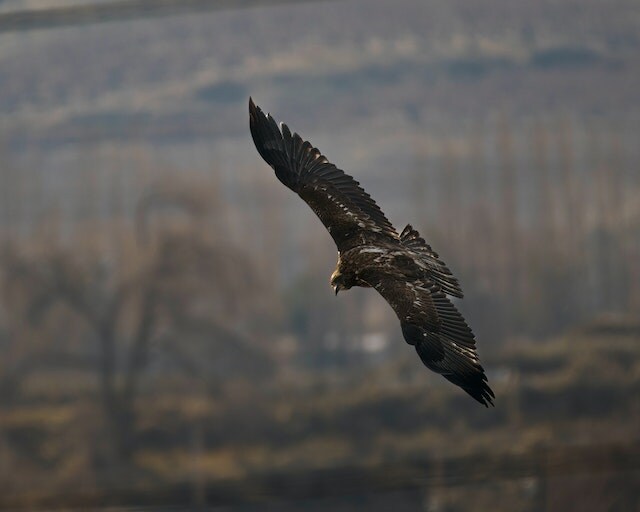
The Importance of Eagles’ Eyesight
Eagles possess exceptional visual acuity, which plays a crucial role in their survival and behavior.
Their eyesight is among the most powerful in the animal kingdom, allowing them to spot prey from great distances and accurately judge distances.
This visual acuity is possible due to several adaptations, such as having large eyes that are positioned forward, allowing for binocular vision, and having a high density of photoreceptor cells in their retinas.
Additionally, eagles have a special oil in their eyes that cleans and protects them from dust and debris, ensuring clear vision.
These adaptations for hunting have allowed eagles to become successful predators, and their visual acuity is vital for survival in their natural habitats.
As we move on to the next section about the flight abilities of eagles, it is important to recognize how their exceptional eyesight enables them to navigate and hunt while in flight.
Flight Abilities of Eagles
The awe-inspiring flight abilities of these majestic birds of prey never fail to captivate and astound observers.
Eagles have evolved a range of physical adaptations that allow them to perform impressive aerial feats, including their distinctive wingspan, powerful muscles, and lightweight bones.
These adaptations enable them to soar through the air with grace and speed, using different flight patterns depending on their hunting strategies and environmental factors.
For example, eagles will often use thermal updrafts to gain altitude without expending too much energy, and then glide down to their prey with incredible speed and precision.
Their sharp talons and hooked beaks also play a critical role in their hunting techniques, allowing them to snatch prey from the ground or water with ease.
Overall, the flight abilities of eagles are truly remarkable, and understanding their physical adaptations and hunting strategies is key to appreciating the full range of their incredible abilities.
As we delve into the next section on hunting techniques of eagles, we will explore how these birds of prey use their flight skills to capture their prey in the wild.
Hunting Techniques of Eagles
Through the use of their aerial agility and sharp talons, eagles are able to effectively capture prey in a variety of different hunting techniques. These techniques include:
1) Soaring, where eagles fly high in the sky while scouting for prey and then dive down at high speeds to snatch their target with their talons.
2) Ambushing, where eagles hide in trees or other cover and then surprise their prey with a sudden attack.
3) Chasing, where eagles pursue their prey in flight until they are close enough to make a successful attack.
Eagles are known to prey on a wide variety of animals, including fish, small mammals, and even other birds.
Their hunting behavior is a testament to their superior aerial abilities and their adaptability as predators.
As we look at the comparison of eagles to other birds of prey, we can see that eagles stand out as some of the most skilled and versatile hunters in the animal kingdom.
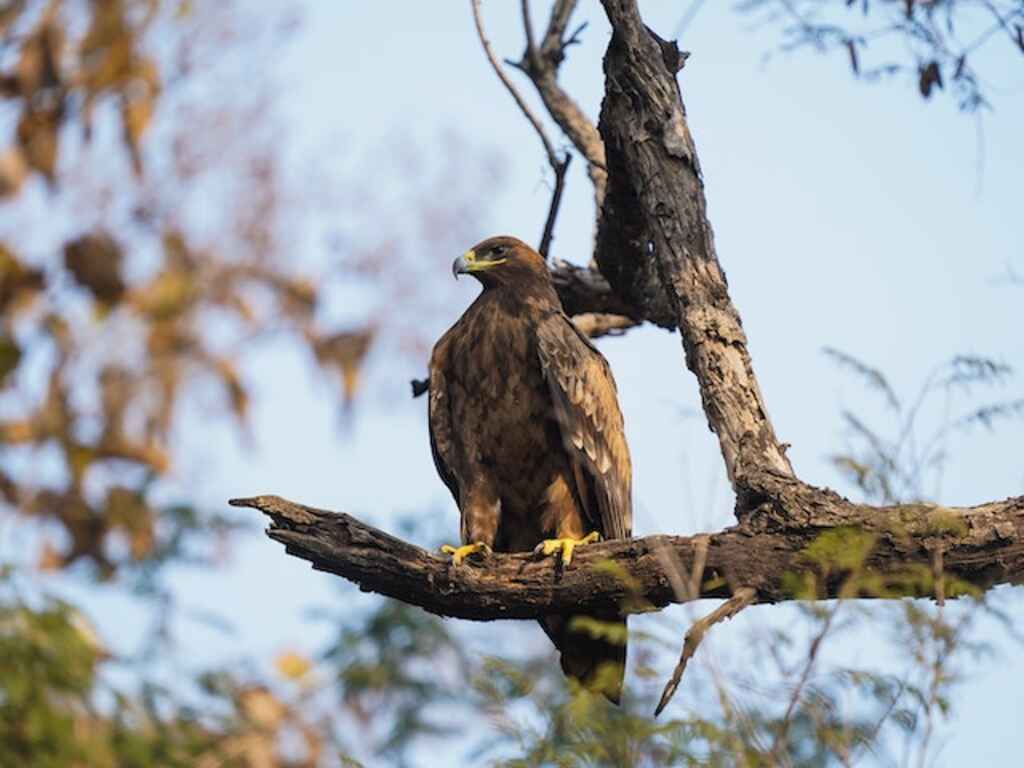
Comparison of Eagles to Other Birds of Prey
Having explored the hunting techniques of eagles in the previous section, let us now delve into the physical characteristics and behavioral differences that set eagles apart from other birds of prey.
In terms of physical attributes, eagles are often compared to falcons and hawks, with the former having a longer wingspan but the latter possessing sharper talons.
Eagles also differ in behavior from vultures and ospreys, with the former being more aggressive and territorial, and the latter being more efficient at catching fish.
To better understand these differences, let us examine the following table:
| Physical Attribute | Eagles | Falcons | Hawks |
|---|---|---|---|
| Wingspan | 6-7 feet | 2-4 feet | 3-4 feet |
| Talons | Large and powerful | Sharp and agile | Shorter and less powerful |
| Behavioral Difference | Eagles | Vultures | Ospreys |
|---|---|---|---|
| Hunting Behavior | Aggressive and territorial | Scavengers | Efficient fish hunters |
| Nesting Habits | High in trees or cliffs | Ground nests | Nests near water |
Despite these differences, eagles have a unique majesty and grace that capture the imagination of many. In the next section, we will explore the role of eagles in mythology and culture.
Eagles in Mythology and Culture
Eagles have held a significant place in mythology and culture throughout history, with numerous civilizations viewing them as symbols of power and strength.
In art, eagles have been depicted as fierce and majestic creatures, often used to represent nations and empires.
In literature, eagles have been used as metaphors to represent freedom and independence, with many authors using them to symbolize the human spirit.
The eagle’s impressive physical attributes, including its sharp talons and powerful wingspan, have also made it a popular design choice for logos and emblems.
However, despite the eagle’s enduring cultural significance, its populations have been threatened by habitat loss, pollution, and hunting.
As a result, many species of eagles are now endangered, and efforts are being made to protect and preserve these iconic birds.
Endangered Status of Eagles
The dwindling habitats, pollution, and hunting have led to the endangered status of several species of eagles, making their survival uncertain in the future.
Conservation efforts have been made to protect these majestic birds; however, habitat destruction continues to threaten their existence, resulting in a decline in their populations.
The Bald Eagle, for example, was once on the brink of extinction due to hunting and pesticide use, but through conservation efforts, it has made a remarkable recovery.
Despite this success, many other species of eagles remain endangered, including the Philippine Eagle, the Harpy Eagle, and the African Crowned Eagle.
As humans continue to expand into natural habitats, the future of these birds remains uncertain.
The importance of preserving these magnificent creatures cannot be overstated, as they play a crucial role in the ecosystem.
They are apex predators and help maintain the balance of their respective ecosystems.
It is vital that we recognize the impact of our actions and take steps towards preserving the habitats of these magnificent birds.
Speaking of preservation, there are several places to see eagles in the wild.
Places to See Eagles in the Wild
Several locations around the world offer opportunities to observe eagles in their natural habitats. Bird watching enthusiasts can find these majestic creatures in various regions such as North America, Europe, and Asia.
The Bald Eagle, the national bird and symbol of the United States, can be spotted along the coastlines of Alaska, Canada, and the Pacific Northwest.
The Golden Eagle, one of the largest birds of prey, can be found in the mountain ranges of Europe, Asia, and North America.
To observe the White-tailed Eagle, one can visit the Baltic Sea coastlines of Poland and Germany.
Conservation efforts have played a crucial role in preserving these magnificent birds and their habitats.
Several organizations have been working to protect eagles from threats like habitat loss, hunting, and pollution.
Witnessing these awe-inspiring creatures in their natural habitats is not only a thrilling experience but also a reminder of the importance of preserving our natural world.
As we move onto final thoughts on eagles and their beauty, it is essential to remember the significance of conservation efforts in protecting these magnificent creatures.
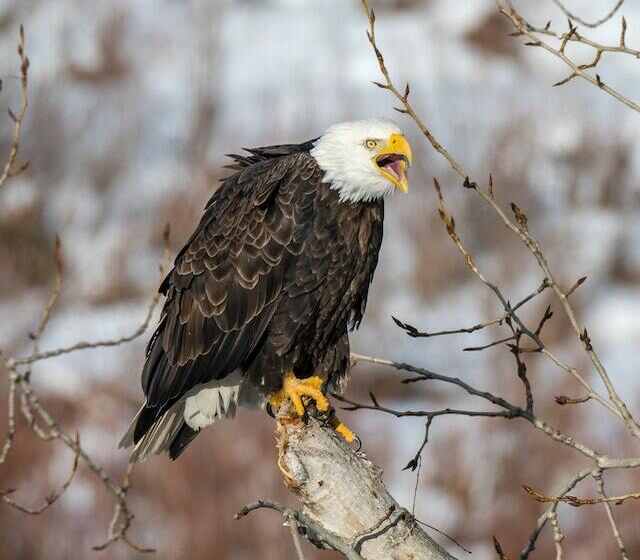
Final Thoughts on Eagles and their Beauty
Conservation of eagle habitats is crucial in preserving the natural beauty of these majestic birds, as they serve as a symbolic representation of the importance of protecting our environment.
Appreciating the beauty of eagles is not only a visual experience but also a cultural one. These birds have been revered throughout history for their strength, freedom, and spiritual significance.
To truly appreciate their beauty, we must imagine them soaring through pristine landscapes, their sharp eyes scanning the horizon for prey, their powerful wings gliding effortlessly through the air.
The sound of their piercing calls echoes through the mountains, a reminder of the wonder and awe that nature can inspire.
In order to preserve the cultural significance and beauty of eagles, it is essential to protect their habitats and ensure their survival for future generations to enjoy.
Frequently Asked Questions
Are there any species of eagles that are not endangered?
Several species of eagles, such as the Bald Eagle and Golden Eagle, are not currently considered endangered due to conservation efforts. However, some populations still face threats from habitat loss and human activities.
How do eagles communicate with each other?
Eagles communicate with each other through a variety of vocalizations and body language cues. They use specific calls for mating, territorial defense, and warning of danger. Their body language includes posturing, wing displays, and tail movements.
What is the average lifespan of an eagle in captivity?
Although eagles can live up to 30 years in the wild, those in captivity have a shorter lifespan due to their restricted environment. Proper care and feeding, as well as training techniques, can prolong their life.
Can eagles swim?
Eagles, while known for their aerial prowess, exhibit limited aquatic habits. They are capable of swimming short distances, but not for extended periods, as their feathers become waterlogged. Eagles are not considered primarily aquatic birds.
How do eagles adapt to different environments?
Eagles adapt to different environments through various adaptation techniques such as altering their diet, changes in behavior, and physiological adaptations. They also adapt to habitat changes brought about by climate change, human activities, and natural disasters.
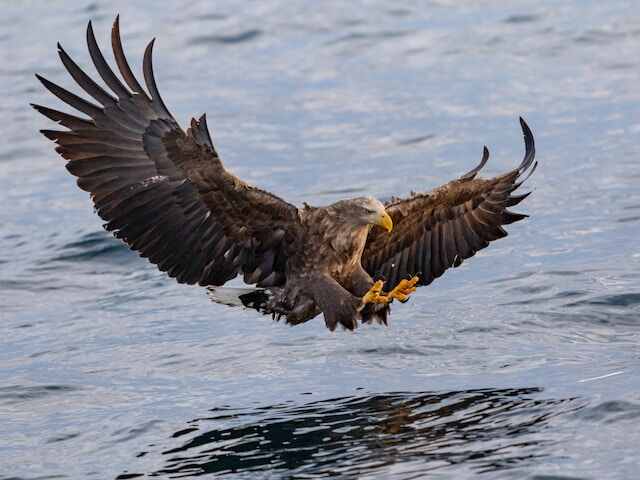
Conclusion
In conclusion, it is evident that eagles are fascinating creatures with remarkable physical abilities.
Their impressive size and strength, coupled with their keen eyesight and exceptional flight skills, make them a force to be reckoned with in the animal kingdom.
Despite their endangered status, eagles continue to captivate and inspire humans around the world with their beauty and significance in mythology and culture.
Indeed, it is difficult not to be in awe of these majestic creatures who have been revered throughout history.
Whether soaring through the skies or perched atop a tree, eagles command attention and respect. It is no wonder that they have become a symbol of power, freedom, and courage.
As we continue to work towards their preservation, let us not forget the wonder and majesty that eagles bring to our world.

